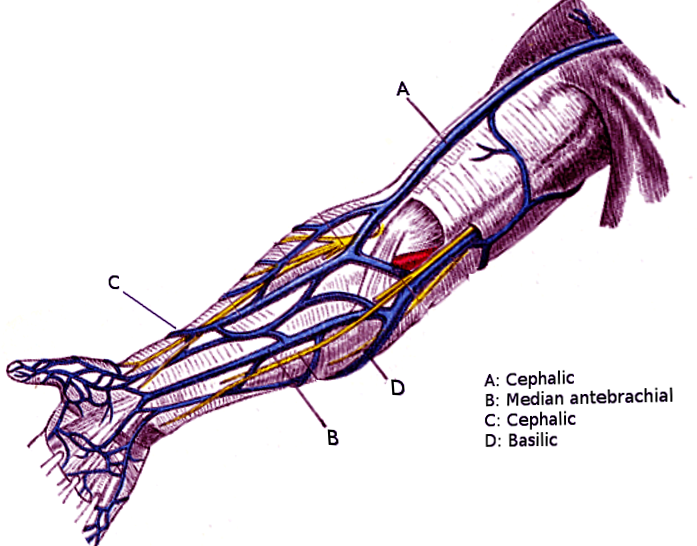[1]
Radkowski CA, Richards RS, Pietrobon R, Moorman CT 3rd. An anatomic study of the cephalic vein in the deltopectoral shoulder approach. Clinical orthopaedics and related research. 2006 Jan:442():139-42
[PubMed PMID: 16394752]
[2]
Loukas M, Myers CS, Wartmann ChT, Tubbs RS, Judge T, Curry B, Jordan R. The clinical anatomy of the cephalic vein in the deltopectoral triangle. Folia morphologica. 2008 Feb:67(1):72-7
[PubMed PMID: 18335417]
[3]
Araújo RC, Pires LAS, Andrade ML, Perez MC, Filho CSL, Babinski MA. Embryological and comparative description of the cephalic vein joining the external jugular vein: A case report. Morphologie : bulletin de l'Association des anatomistes. 2018 Mar:102(336):44-47. doi: 10.1016/j.morpho.2017.10.002. Epub 2017 Nov 11
[PubMed PMID: 29133232]
Level 2 (mid-level) evidence
[4]
Ma CX, Pan WR, Liu ZA, Zeng FQ, Qiu ZQ, Liu MY. Deep lymphatic anatomy of the upper limb: An anatomical study and clinical implications. Annals of anatomy = Anatomischer Anzeiger : official organ of the Anatomische Gesellschaft. 2019 May:223():32-42. doi: 10.1016/j.aanat.2019.01.005. Epub 2019 Feb 1
[PubMed PMID: 30716466]
Level 2 (mid-level) evidence
[5]
Forro SD, Munjal A, Lowe JB. Anatomy, Shoulder and Upper Limb, Arm Structure and Function. StatPearls. 2023 Jan:():
[PubMed PMID: 29939618]
[6]
Sadeghi A, Setayesh Mehr M, Esfandiari E, Mohammadi S, Baharmian H. Variation of the cephalic and basilic veins: A case report. Journal of cardiovascular and thoracic research. 2017:9(4):232-234. doi: 10.15171/jcvtr.2017.40. Epub 2017 Oct 15
[PubMed PMID: 29391938]
Level 3 (low-level) evidence
[7]
Lee HS, Song YR, Kim JK, Choi SR, Joo N, Kim HJ, Park P, Kim SG. Anatomical variants of upper arm veins on preoperative mapping venography for hemodialysis access in Korean adults. The journal of vascular access. 2019 May:20(3):270-275. doi: 10.1177/1129729818803870. Epub 2018 Oct 11
[PubMed PMID: 30306819]
[8]
Fontseré N, Mestres G, Yugueros X, Jiménez M, Burrel M, Gómez F, Ojeda R, Rodas LM, Lozano V, Riambau V, Maduell F. Brachiobasilic arteriovenous fistula with superficialisation and transposition the basilic vein in a one stage surgical technique. Five years of single experience. Nefrologia. 2019 Jul-Aug:39(4):388-394. doi: 10.1016/j.nefro.2018.11.010. Epub 2019 Mar 8
[PubMed PMID: 30853141]
[9]
Sheta M, Hakmei J, London M, Wooster M, Aruny J, Ross J, Illig KA. One- versus two-stage transposed brachiobasilic arteriovenous fistulae: A review of the current state of the art. The journal of vascular access. 2020 May:21(3):281-286. doi: 10.1177/1129729819862694. Epub 2019 Aug 1
[PubMed PMID: 31366302]
[10]
Gehl HB, Bohndorf K, Gladziwa U, Handt S, Günther RW. Imaging of hemodialysis fistulas: limitations of MR angiography. Journal of computer assisted tomography. 1991 Mar-Apr:15(2):271-5
[PubMed PMID: 2002107]
[11]
Brittenden J, Cooper D, Dimitrova M, Scotland G, Cotton SC, Elders A, MacLennan G, Ramsay CR, Norrie J, Burr JM, Campbell B, Bachoo P, Chetter I, Gough M, Earnshaw J, Lees T, Scott J, Baker SA, Tassie E, Francis J, Campbell MK. Five-Year Outcomes of a Randomized Trial of Treatments for Varicose Veins. The New England journal of medicine. 2019 Sep 5:381(10):912-922. doi: 10.1056/NEJMoa1805186. Epub
[PubMed PMID: 31483962]
Level 1 (high-level) evidence
[12]
Lindblad B, Bornmyr S, Kullendorff B, Bergqvist D. Venous haemodynamics of the upper extremity after subclavian vein thrombosis. VASA. Zeitschrift fur Gefasskrankheiten. 1990:19(3):218-22
[PubMed PMID: 2238816]
[13]
Sanson H, Gautier V, Stansal A, Sfeir D, Franceschi C, Priollet P. [Deep venous thrombosis of the upper limb in a violin player: The "bow syndrome"]. Journal des maladies vasculaires. 2016 Dec:41(6):396-402. doi: 10.1016/j.jmv.2016.10.004. Epub 2016 Nov 4
[PubMed PMID: 27823916]
[14]
Shiva C, Saini M. Paget-von Schroetter Syndrome: Upper Extremity Deep Vein Thrombosis after Continuous Lifting of Heavy Weight. The Journal of the Association of Physicians of India. 2015 Aug:63(8):84-5
[PubMed PMID: 27604444]
[15]
Rainey CE, Taysom DA, Rosenthal MD. Upper extremity deep venous thrombosis. The Journal of orthopaedic and sports physical therapy. 2014 Apr:44(4):313. doi: 10.2519/jospt.2014.0405. Epub
[PubMed PMID: 24684195]
[16]
Thayalasekaran S, Liddicoat H, Wood E. Thrombophlebitis migrans in a man with pancreatic adenocarcinoma: a case report. Cases journal. 2009 Apr 29:2():6610. doi: 10.1186/1757-1626-2-6610. Epub 2009 Apr 29
[PubMed PMID: 19829832]
Level 3 (low-level) evidence

